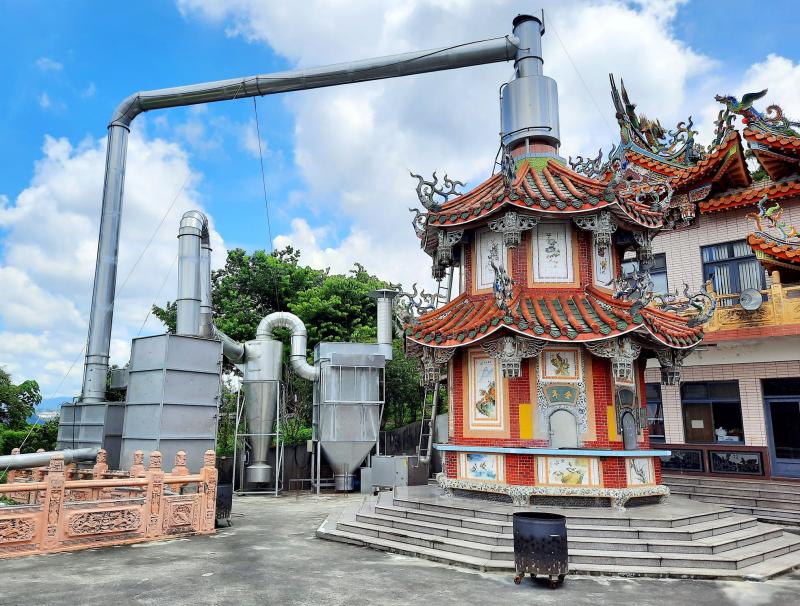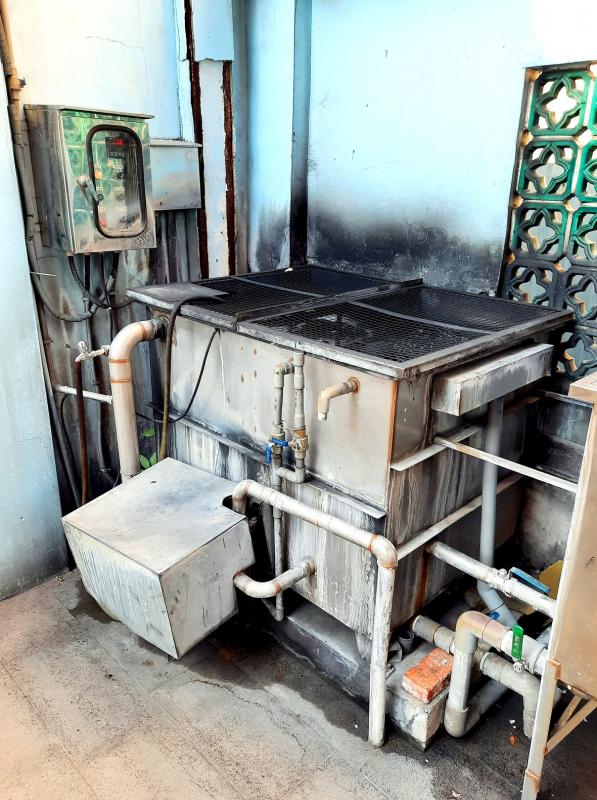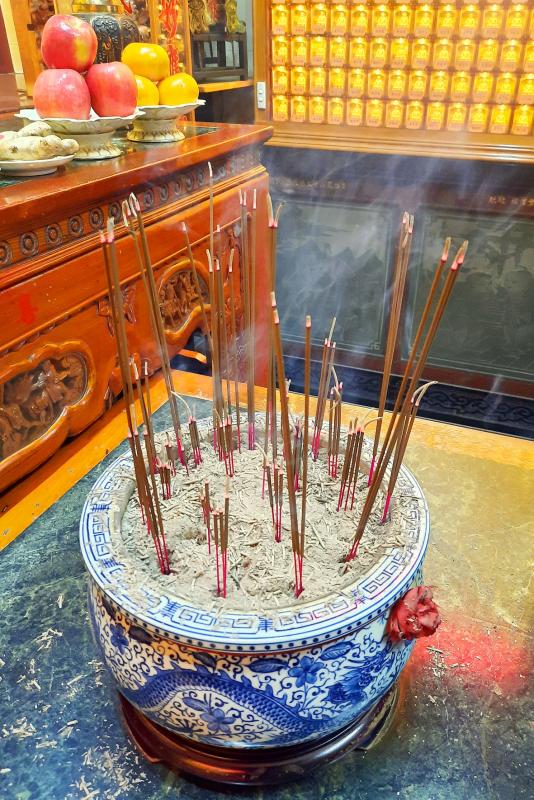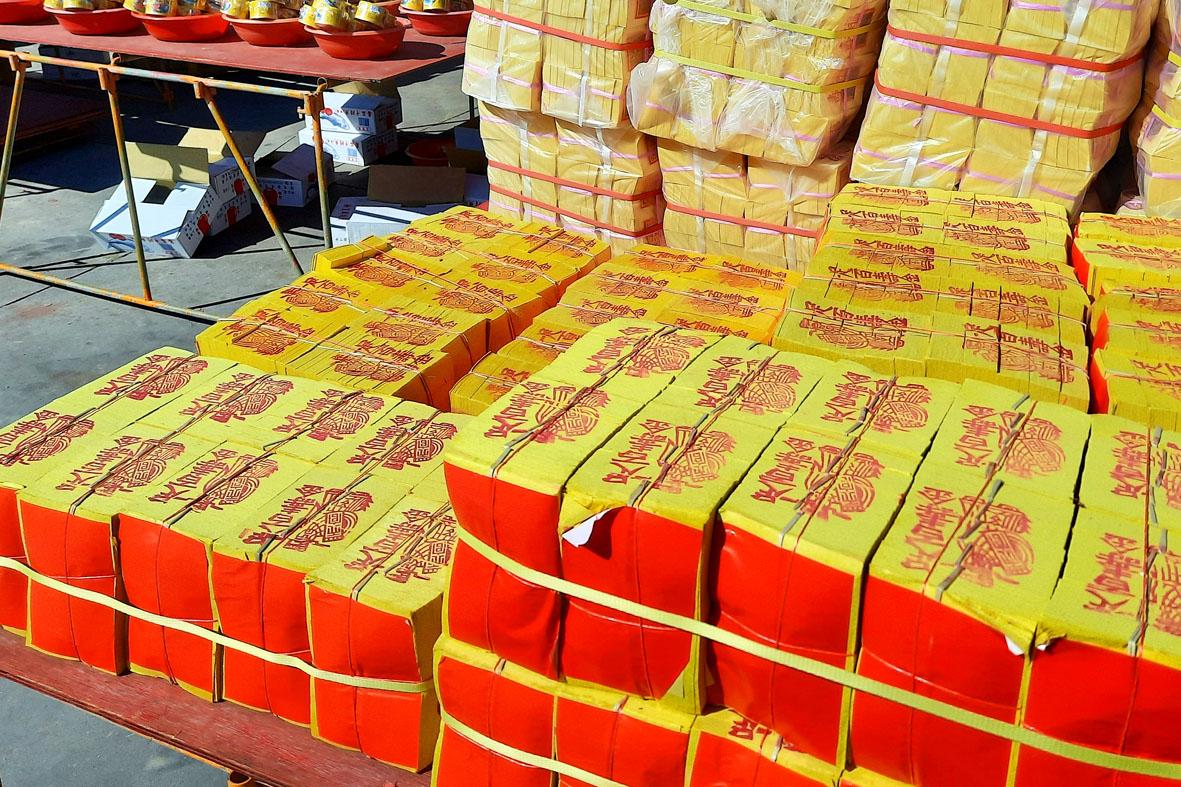The first Monday of this year was also the first day of the twelfth month on the traditional lunisolar calendar. As they do at the start of every lunar month — and again on the fifteenth day — countless people across Taiwan positioned circular braziers in front of their homes, and set about burning sheaves of joss paper.
The ritual burning of incense and joss paper (which English speakers sometimes call ghost money, spirit money or votive currency) is central to local religious and ancestor-worshipping traditions. Unfortunately, it has a noticeably detrimental effect on air quality, especially in urban areas.
Because some people begin burning joss paper soon after dawn, children on their way to school are among those exposed to high concentrations of particulate matter (PM).

Photo: Steven Crook
The Environmental Protection Administration’s (EPA) Web site, on a page dated Aug. 18, 2017, points out that burning joss paper produces sulfur oxides, nitrogen oxides, carbon monoxide and fine suspended particles, as well as carcinogenic substances such as benzene, formaldehyde, toluene and polycyclic aromatic hydrocarbons.
The same page states that, in 2016, Taiwanese consigned to flames around 195,000 tonnes of joss paper and 21,000 tonnes of incense. According to another estimate, 280,000 tonnes of votive currency go up in smoke each year. It takes around 24 trees to make one tonne of paper. Some joss paper is made of recycled paper, but that may well produce even more dangerous emissions.
Academia Sinica’s Research Center for Environmental Changes has studied air quality in and around temples. In 2014, it concluded that, on days with significant religious activity, PM10 levels at major temples are 5 to 16 times those in a typical urban home, while houses near temples show increased PM2.5 levels.

Photo: Steven Crook
Scientists from at least three local universities have said that the air quality within temples is frequently hazardous to both staff and worshipers.
In 2018, EPA personnel monitoring the Dajia Matsu Pilgrimage in central Taiwan found that PM2.5 concentrations along the route reached up to 1,400 μm/m3 (micrograms per cubic meter), due to firecrackers, fireworks, incense and joss paper. This is far beyond what’s acceptable for humans. Last year, the WHO set PM2.5 targets of 10 to 35 μm/m3.
Activists have been urging an end to the habit of immolating joss paper since the period of Japanese colonial rule. Chiang Wei-shui (蔣渭水), a democracy pioneer and founder of the Taiwanese Cultural Association, argued that superstition and what he called “ugly customs” should be eliminated.

Photo: Steven Crook
Chiang led by example. When his parents passed away, neither mock money nor candles were burned at their funerals. In one of his articles, he categorized joss paper burning as a vice on a par with opium consumption.
POWERFUL TEMPLE LOBBY
The temple lobby in Taiwan is powerful, and (contrary to what some religious leaders imply) no central or local government unit has proposed an outright ban on burning rituals. The authorities have tried various ways to reduce the fire and smoke generated by popular religion, without much success.

Photo: Steven Crook
A campaign to get Taiwanese to burn “ghost credit cards” for their forefathers, instead of bundles of mock cash, ran up against the internal logic of ancestor worship. Like the living, the deceased need money if they’re to enjoy a comfortable existence. Some of the former justified their reluctance to change this way: People who died decades ago, and perhaps didn’t attend school, aren’t likely to understand or trust cashless payment systems.
On Jan. 2, the Tainan-based China Daily News reported that a procession the previous day, organized by the city’s Shengan Temple (勝安宮), had created “dense smoke and serious air pollution.” Consequently, the temple would be fined up to NT$100,000. (The same day, a different temple in another part of Tainan was facing a fine of NT$30,000 for a celebration that breached noise limits.)
For many temples in Taiwan, NT$100,000 isn’t a lot of money.
Resistance doesn’t just come from superstitious folk convinced that disaster will surely follow if they don’t propitiate the gods and ghosts that inhabit other realms.
In 2017, Chen Wei-cheng (陳韋誠) — then a student in National Chiao Tung University’s Graduate Program of Ethnicity and Culture — decried government efforts to rein in ritual burning in op-eds published by the Think Folklore Web site (think.folklore.tw).
Chen described official requests that worshipers offer rice instead of sacrificing joss paper (以米代金), or replace burning rituals with meritorious acts (以功代金 or 以善代金), as “absurd.” Such approaches, he wrote, were “imaginary alternatives, constructed by continuously stigmatizing folk beliefs and the use of incense and joss paper as polluting.”
Saying that rice and joss paper play distinct and non-overlapping roles in sacrifice ceremonies, he claimed that the burning of incense and votive currency “are the material basis of Taiwanese popular religion.”
His articles generated dozens of comments, few of which were supportive.
Taiwan’s indigenous community no longer engages in headhunting, despite the cultural significance it once held, said one person. Another argued that joss paper is no more irreplaceable than the “divine pigs” that are fattened (often forcibly, until they can no longer stand) ahead of certain Hakka festivals; that custom, which animal-rights activists say is cruel, seems to be in decline.
Faith does not encourage extravagance and waste, said a third. Several expressed certainty that the gods would agree with policies that protect the environment. And one person put it this way: “The gods know what you do. Belief is the relationship between the individual and the gods, and it has nothing to do with the burning of joss paper.”
Some temples have displayed impressive leadership on environmental matters. Among them is Puli Confucius Temple (埔里孔子廟). It ended joss-paper sacrifices in 1961, and has persuaded other shrines in the area to follow suit.
Other religious institutions are dragging their feet. Those in charge sometimes engage in whataboutism, saying the EPA shouldn’t pressure them to change, because pollution caused by the pious is but a fraction of that produced by Taiwan’s factories and motor vehicles.
Small World, a Shih Hsin University student publication, on May 11, 2018 quoted Chen Yu-feng (陳玉峰), chairman of Taipei’s Songshan Ciyou Temple (松山慈祐宮) as opposed to government efforts to reduce the use of incense and joss paper.
SELF REGULATION
The removal of censers and joss-paper furnaces might not matter to famous and wealthy places of worship such as Xingtian Temple (行天宮) and Mengjia Longshan Temple (艋舺龍山寺) in Taipei, he said. In recent years, both temples opted to “go green” and end all burning rituals.
However, Chen implied, it would reduce the number of people attending (and buying joss paper at) smaller shrines, thereby undermining their ability to stay open.
Chen said that Ciyou Temple donates eco-friendly firecrackers to affiliated shrines, while the joss paper and incense now used inside the temple are SGS-approved. He urged the government to help local companies manufacture incense and joss paper without the use of harmful chemicals.
Stressing that the authorities shouldn’t limit religious expression, Chen said temples should make changes on their own initiative. However, the histories of numerous industries show that simply waiting for people to do the right thing seldom produces ideal results.
A July 5, 2017 China Times report on a gathering of temple leaders quoted one as saying that “centralized incineration” — collecting offerings of joss paper so they can be burned in a trash incinerator equipped with pollution-control technologies — was “humiliating for believers.”
More and more temples have retrofitted scrubbers to their joss-paper furnaces. According to Lo Yu-yun’s (羅玉雲) 2012 doctoral dissertation on this type of hardware, dry (baghouse) scrubbers remove up to 99 percent of PM, while wet scrubbers are about 70 percent effective.
Such systems aren’t prohibitively expensive. Lo stated that the cost of a dry scrubber capable of handling 40kg of joss paper per hour is around US$10,000. A wet scrubber may cost half of that. Operating expenses aren’t high, but dry scrubbers are rare because they require a lot of floorspace.
Joss-paper furnaces with scrubbers do nothing to reduce popular religion’s carbon emissions. In fact, they’re like adding filters to cigarettes: An excuse not to quit.
The authorities have shown a willingness to upset Taiwan’s smokers with ever-higher taxes and ever-tighter restrictions. Will they show the same resolve when it comes to the smoke, ash, and odor associated with religious traditions?
Steven Crook, the author or co-author of four books about Taiwan, has been following environmental issues since he arrived in the country in 1991. He drives a hybrid and carries his own chopsticks. The views expressed here are his own.

That US assistance was a model for Taiwan’s spectacular development success was early recognized by policymakers and analysts. In a report to the US Congress for the fiscal year 1962, former President John F. Kennedy noted Taiwan’s “rapid economic growth,” was “producing a substantial net gain in living.” Kennedy had a stake in Taiwan’s achievements and the US’ official development assistance (ODA) in general: In September 1961, his entreaty to make the 1960s a “decade of development,” and an accompanying proposal for dedicated legislation to this end, had been formalized by congressional passage of the Foreign Assistance Act. Two

Despite the intense sunshine, we were hardly breaking a sweat as we cruised along the flat, dedicated bike lane, well protected from the heat by a canopy of trees. The electric assist on the bikes likely made a difference, too. Far removed from the bustle and noise of the Taichung traffic, we admired the serene rural scenery, making our way over rivers, alongside rice paddies and through pear orchards. Our route for the day covered two bike paths that connect in Fengyuan District (豐原) and are best done together. The Hou-Feng Bike Path (后豐鐵馬道) runs southward from Houli District (后里) while the

March 31 to April 6 On May 13, 1950, National Taiwan University Hospital otolaryngologist Su You-peng (蘇友鵬) was summoned to the director’s office. He thought someone had complained about him practicing the violin at night, but when he entered the room, he knew something was terribly wrong. He saw several burly men who appeared to be government secret agents, and three other resident doctors: internist Hsu Chiang (許強), dermatologist Hu Pao-chen (胡寶珍) and ophthalmologist Hu Hsin-lin (胡鑫麟). They were handcuffed, herded onto two jeeps and taken to the Secrecy Bureau (保密局) for questioning. Su was still in his doctor’s robes at

Mirror mirror on the wall, what’s the fairest Disney live-action remake of them all? Wait, mirror. Hold on a second. Maybe choosing from the likes of Alice in Wonderland (2010), Mulan (2020) and The Lion King (2019) isn’t such a good idea. Mirror, on second thought, what’s on Netflix? Even the most devoted fans would have to acknowledge that these have not been the most illustrious illustrations of Disney magic. At their best (Pete’s Dragon? Cinderella?) they breathe life into old classics that could use a little updating. At their worst, well, blue Will Smith. Given the rapacious rate of remakes in modern